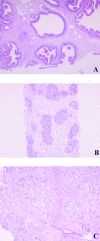Single nucleotide polymorphism profiling assay to confirm the identity of human tissues
- PMID: 17384212
- PMCID: PMC1867440
- DOI: 10.2353/jmoldx.2007.060059
Single nucleotide polymorphism profiling assay to confirm the identity of human tissues
Abstract
To identify issues of sample mix-ups, various molecular techniques are currently used. These techniques, however, are time consuming and require experience and/or DNA sequencing equipment or have a relatively high risk of errors because of contamination. Therefore, a quick and straightforward single nucleotide polymorphism (SNP) profiling assay was developed to link human tissues to a source. SNPs are common sequence variations in the human genome, and each individual has a unique combination of these nucleotide variations. Using potentially mislabeled paraffin-embedded tissues, DNA was extracted and SNP profiles were determined by real-time polymerase chain reaction analysis of the purified DNA using a selection of 10 commercially available SNP amplification assays. These profiles were compared with profiles of the supposed owners. All issues (34 in total) of potential sample mix-ups during the last 3 years were adequately solved, with six cases described here. The SNP profiling assay provides a quick (within 24 hours), easy, and reliable way to link human samples to a source, without polymerase chain reaction postprocessing. The chance for two randomly chosen individuals to have an identical profile is 1 in 18,000. Solving potential sample mix-ups will secure downstream evaluations and critical decisions concerning the patients involved.
Figures





Similar articles
-
Single nucleotide polymorphism profiling assay to exclude serum sample mix-up.Vox Sang. 2007 Feb;92(2):148-53. doi: 10.1111/j.1423-0410.2006.00871.x. Vox Sang. 2007. PMID: 17298578
-
Mass spectrometry-based loss of heterozygosity analysis of single-nucleotide polymorphism loci in paraffin embedded tumors using the MassEXTEND assay: single-nucleotide polymorphism loss of heterozygosity analysis of the protein tyrosine phosphatase receptor type J in familial colorectal cancer.J Mol Diagn. 2005 Nov;7(5):623-30. doi: 10.1016/S1525-1578(10)60596-X. J Mol Diagn. 2005. PMID: 16258161 Free PMC article.
-
Fluorescent microsphere-based readout technology for multiplexed human single nucleotide polymorphism analysis and bacterial identification.Hum Mutat. 2001 Apr;17(4):305-16. doi: 10.1002/humu.28. Hum Mutat. 2001. PMID: 11295829
-
Technology insight: Application of molecular techniques to formalin-fixed paraffin-embedded tissues from breast cancer.Nat Clin Pract Oncol. 2005 May;2(5):246-54. doi: 10.1038/ncponc0171. Nat Clin Pract Oncol. 2005. PMID: 16264960 Review.
-
Multiple testing in the genomics era: findings from Genetic Analysis Workshop 15, Group 15.Genet Epidemiol. 2007;31 Suppl 1:S124-31. doi: 10.1002/gepi.20289. Genet Epidemiol. 2007. PMID: 18046761 Review.
Cited by
-
Clinical Validation of Discordant Trunk Driver Mutations in Paired Primary and Metastatic Lung Cancer Specimens.Am J Clin Pathol. 2019 Oct 7;152(5):570-581. doi: 10.1093/ajcp/aqz077. Am J Clin Pathol. 2019. PMID: 31264684 Free PMC article.
-
Comparative analysis of four methods to extract DNA from paraffin-embedded tissues: effect on downstream molecular applications.BMC Res Notes. 2010 Sep 14;3:239. doi: 10.1186/1756-0500-3-239. BMC Res Notes. 2010. PMID: 20840759 Free PMC article.
-
Exploration of identifying individual tumor tissue based on probabilistic model.Front Oncol. 2024 Apr 23;14:1297135. doi: 10.3389/fonc.2024.1297135. eCollection 2024. Front Oncol. 2024. PMID: 38715774 Free PMC article.
-
Identification and Correction of Sample Mix-Ups in Expression Genetic Data: A Case Study.G3 (Bethesda). 2015 Aug 19;5(10):2177-86. doi: 10.1534/g3.115.019778. G3 (Bethesda). 2015. PMID: 26290572 Free PMC article.
-
Single-nucleotide-polymorphism genotyping of Coxiella burnetii during a Q fever outbreak in The Netherlands.Appl Environ Microbiol. 2011 Mar;77(6):2051-7. doi: 10.1128/AEM.02293-10. Epub 2011 Jan 21. Appl Environ Microbiol. 2011. PMID: 21257816 Free PMC article.
References
-
- Lind AC, Bewtra C, Healy JC, Sims KL. Prospective peer review in surgical pathology. Am J Clin Pathol. 1995;104:560–566. - PubMed
-
- Renshaw AA, Young ML, Jiroutek MR. How many cases need to be reviewed to compare performance in surgical pathology? Am J Clin Pathol. 2003;119:388–391. - PubMed
-
- Renshaw AA, Cartagena N, Granter SR, Gould EW. Agreement and error rates using blinded review to evaluate surgical pathology of biopsy material. Am J Clin Pathol. 2003;119:797–800. - PubMed
-
- Ramsay AD, Gallagher PJ. Local audit of surgical pathology. 18 month’s experience of peer review-based quality assessment in an English teaching hospital. Am J Surg Pathol. 1992;16:476–482. - PubMed
-
- Safrin RE, Bark CJ. Surgical pathology sign-out. Routine review of every case by a second pathologist. Am J Surg Pathol. 1993;17:1190–1192. - PubMed
MeSH terms
Substances
LinkOut - more resources
Full Text Sources
Other Literature Sources
Medical

